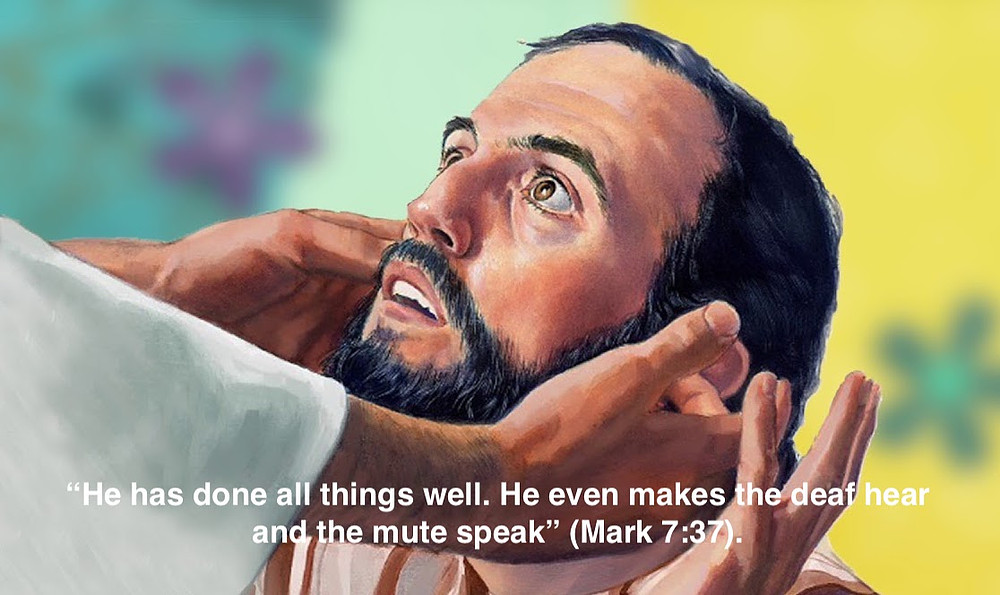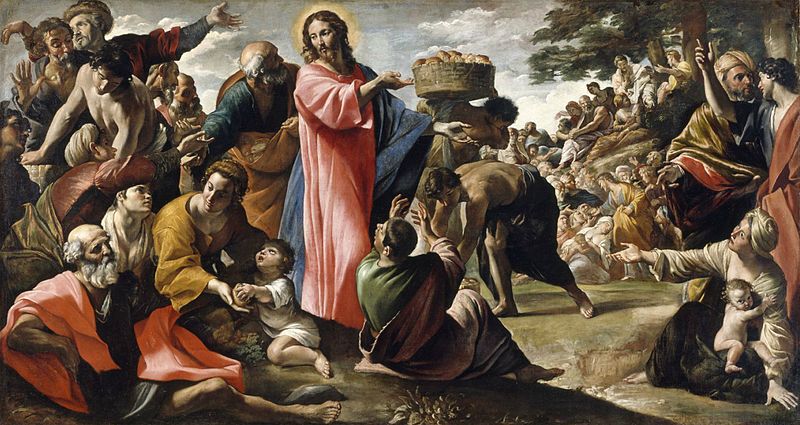25 but a woman whose little daughter had an unclean spirit immediately heard about him, and she came and bowed down at his feet.…
35 And immediately his ears were opened, his tongue was released, and he spoke plainly…
8 They ate and were filled; and they took up the broken pieces left over, seven baskets full. [Mark 7:25; 7:35; 8:8, NRSV]
[L] Christ and the Syro-Phoenician woman, by Pieter Lastman, 1625; [M] Jesus heals a deaf and mute man; [R] Miracle of the Bread and Fish, by Giovanni Lanfranco, c.1621.
The Evangelist Mark has a way of arranging his materials that lends itself to fruitful reflection. Three miracles performed by Jesus in pagan territory in quick succession, for example, after Jesus has been experiencing rejection from the Jewish religious elders in Galilee, readily invite reflection into the journey of discipleship. In the order of appearance of these miracles, a woman comes out in search of Jesus and falls dawn at his feet (7:25), a deaf and mute man, his ears opened and his tongue loosened by Jesus, learns to hear and speak plainly (7:35), and hungry people are fed by Jesus in the wilderness, sharing bread and are filled (8:8). In Mark My Words, Bible scholar Joseph O’ Hanlon suggests that these three miracles, in the order as Mark has arranged them, sketch a pattern of discipleship for all times: come, listen, share.
- Come (7:24-30)
In Mark’s Gospel, different people came to Jesus for different purposes. With evil tendencies and inclinations in their hearts, the Pharisees had twice teamed up with the Herodians to oppose Jesus (3:6; 12:13). With undisguised hostility to Jesus, these implacable opponents to Jesus are nothing but “leaven of malice and evil”. They came to Jesus, but only to argue and “test” him, just as Satan sought to do in the desert (1:13). Indeed, there are none so blind as those who will not see, so that after all that Jesus has done in healing and other nature miracles, the Pharisees came to Jesus to still demand “a sign from heaven” (8:11).
Unlike the Pharisees and the Herodians, however, a pagan (Syrophoenician) woman from the region of Tyre and Sidon came and fell down at his feet. Her little daughter was seriously sick and she was desperate. She needed help and she came pleading. She had faith that Jesus could and would perform a healing miracle for her little girl. She did not come to argue, to challenge or to test Jesus in any way. She came to beg for compassion and mercy for her sick child and she was willing to do anything to get it. Love for her child and faith in Jesus made for a powerful combination, and Jesus responded with his healing power.
- Listen (7:31-37)
The story of the healing of a deaf and mute man brought by people to Jesus while he was in the region of Decapolis also contrasts sharply with Jesus’ failed attempt to overcome the intransigence of some Pharisees and scribes They refused to come out of their narrow vision and give a proper hearing to what Jesus has to say. Their hearts were hardened and their ears closed. Unfortunately, Jesus’ disciples too, were similarly plagued.
Putting his fingers in the man’s ears and sputum on his tongue, Jesus commanded, “Ephphatha” (“be opened”). His ears thus opened, the man could listen well, and his tongue loosened, he began to speak plainly.
There is in this parable-like event, a reflection of the career of the disciples. As yet, they were blind to what Jesus was really doing; they did not see. Shrouded in worldly visions, they could not listen carefully to the heart of Jesus, so they could not really hear what the Master had been teaching them. With deaf ears and hardened hearts, they could not go on to speak properly about the Good News brought by Jesus. They needed healing as much as the deaf and dumb man Jesus had just healed.
- Share (8:1-9)
The third story Mark immediately brings up is the feeding-miracle of 4,000. This is the second feeding miracle unique in Mark. Once again, the occasion was the gathering of a great crowd with nothing to eat. Jesus, filled with compassion for the crowd, went on to multiply seven loaves made available to him to feed the multitude, with seven baskets full of leftovers afterwards. What followed was extremely irritating and comical at the same time.
First, Mark narrated that despite all that Jesus had done, the Pharisees asked for a sign from heaven. This is as sad and irritating as one can imagine. To such a blind and heart-hardened generation, Jesus refused to entertain them with a sign. Instead, he turned his back on them and boarded a boat to leave for the other side.
Second, in the boat, the encounter with the Pharisees prompted Jesus to warn the disciples to beware of the leaven of the Pharisees and the Herodians. But all that the disciples could link that warning of “leaven” to was their lack of bread for the journey, for “they had only one loaf with them in the boat” (8:14)! Mark made the disciples out to be men so blind that they had not understood a thing that Jesus had done in their presence. This is really comical. But it is not funny. It is extremely sad. The disciples had failed to understand and to grasp the significance of what they have seen and heard. They, too, had hardened hearts. Jesus was so disappointed and exasperated that it showed in his voice. Mark intends Jesus’ comments to resound in the hearts of all disciples:
- “17 And being aware of it, Jesus said to them, “Why do you discuss the fact that you have no bread? Do you not yet perceive or understand? Are your hearts hardened? 18 Having eyes do you not see, and having ears do you not hear? And do you not remember? 19 When I broke the five loaves for the five thousand, how many baskets full of broken pieces did you take up?” They said to him, “Twelve.” 20 “And the seven for the four thousand, how many baskets full of broken pieces did you take up?” (8:17-20).
Mark alone gives us the two passages in all of the New Testament which speak of the hardness of heart of Jesus’ close disciples – 6:52 and 8:17. In so portraying the disciples, Mark couches forcefully the warning to his readers of the challenges of discipleship in every time and place. Disciples are familiar with the idea of the boat as an image of the Christian community where surely “one loaf”, in reference to Jesus in the Eucharist, is sufficient, and where disciples always understand the importance of listening to the Word of Jesus and sharing the Bread of Life.
- “Come, listen, share” has a remarkable resemblance to the process of conversion from paganism to the Christian faith. New converts find their way from paganism to catechetical instructions, then graduate to baptism, and from baptism proceed on to a place at the table of the Eucharist where we celebrate the memoria and eucharistia of “One Bread, One Body” (1 Cor 10:16-17).
Mark will go on to the central section of his Gospel where he narrates Jesus’ journey to Jerusalem (8:22 -10:52).
In this core section, Jesus will thrice predict his passion and death, and embark on serious discipleship-teaching. In a most telling fashion, Mark will frame this entire section by way of two healings of the blind, one unnamed at the front (8:22-26), and the other called Bartimaeus at the end (10:45-52). The unnamed did not follow Jesus after the healing, whereas Bartimaeus did, which perhaps explains why the evangelist included his name. This Markan sandwich structure makes up the section where Jesus opens blind eyes, letting blind men see, thus pointing to the very need of the disciples – the sight to see what Jesus is doing. Mark’s message is clear: Disciples must open their eyes, their minds and hearts, and see clearly who the Master is, what he is doing, and what he wants of those who desire to follow him. Come, listen, share.
Copyright © Dr. Jeffrey & Angie Goh, August 2022. All rights reserved.
You are most welcome to respond to this post. Email your comments to jeffangiegoh@gmail.com. You can also be dialogue partners in this Ephphatha Coffee-Corner Ministry by sending us questions for discussion.



